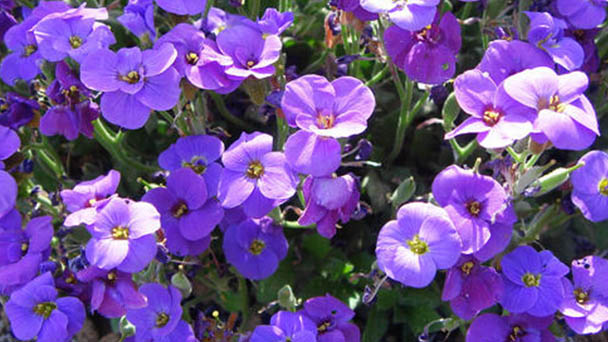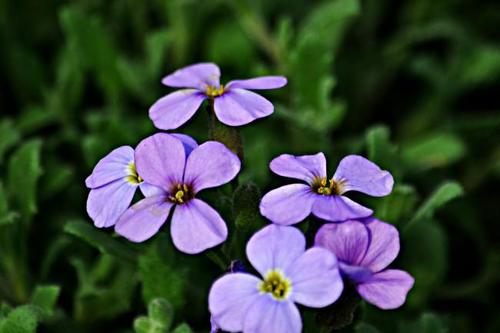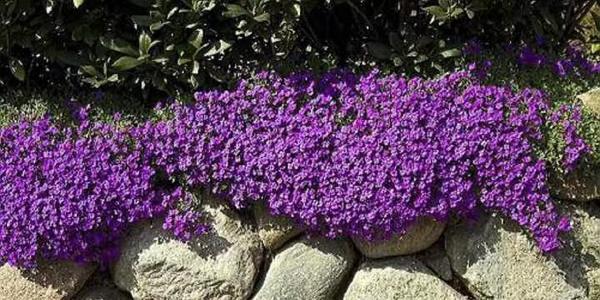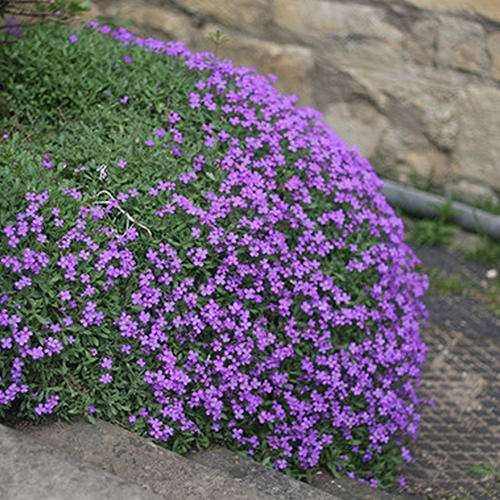Rock cress(Aubrieta cultorum) profile
Written by Maggie
Mar 11 2021

Rock Cress(Aubrieta cultorum) belongs to the family Cruciferae and belongs to the genus Rock Cress. Rock Cress is tough, adaptable and easy to cultivate.
Rock Cress is a perennial herb, clumped but not cushioned, with stellate or forked hairs; Leaves are small, entire or angular serrate; Racemes are terminal, few and large flowers, violet, violet, or white. Flowers are 1.2cm in diameter, fragrant; Flowers are purple to lavender.
Rock Cress is a good variety for early spring applications, with early flowers and large amounts of flowers. It can be used in all kinds of low growth combinations, as well as in villas, parks, Rock gardens and other places. Most cultivated as flowerbeds and rock stems low with stellate hairs and simple leaves. Leaves are small much linear to spatulate alternate, dense racemes calyx erect flowers small white, blue, purple narrow spatulate oblong. Apex emarginate to the entire short pod.
Rock cress picture

Morphological characteristics of rock cress
Rock Cress is a perennial flower, often one - or biennial cultivation, plant height 20-30 cm, 3400 seeds per gram.
Rock Cress plant is 20 -- 30cm tall, clustered, but not cushioned, with stellate or forklike hairs much-branched, and the prostrate plant is 1530cm tall. Leaflets are alternate lanceolate entire or angular serrate. Racemes are terminal flowers few and large, purple, violet, or white.
Simple morphological characteristics and strong vitality can be used for artificial culture on an ordinary medium, 3400 seeds per gram. There are also large-flowered, white-fringed and variegated varieties with a slight fragrance. There are also large-flowered and white-fringed variegated varieties with a 36-month flowering period and flat seeds.
Flowers 1.2cm in diameter with Luce purple to lavender (May to June).
The ecology of rock cress
Rock Cress likes light and drought and can withstand temperatures as low as -15C, so it requires plenty of suns and a bit of shade.
Rock Cress is fond of cold, cool and dry climate, not resistant to cold and hot, and likes loose and well-drained soil, avoiding stagnant water rather than drought-resistant barren soil.
How to grow and care for rock cress
1. Temperature care
Rock Cress is a green plant that can withstand low temperatures, but if the temperature is below zero, it is not suitable for the growth and development of Rock Cress. It is best to maintain the temperature of Rock Cress at 5~26℃. Rock Cress had to be protected from the cold in sub-zero winter temperatures, and water spray had to be sprayed to cool the heat in summer.
2. Sunlight care
In the natural environment with abundant sunlight, the Rock Cress will grow and develop physically and mentally. If the Rock Cress is maintained in the shade, the steep growth of the Rock Cress will be caused and the ornamental value of the Rock Cress will be seriously endangered. In summer, the sun is harsh and moderate shading can be carried out.
3. Soil care
It is better for the soil layer to be loose and breathable, and more stones can be mixed in the bonsai soil, which will be more conducive to the growth and development of Rock Cress. If caking occurs, it is better to carry out ground turning. Because Rock Cress is a perennial herb, plowing the ground a lot is good for growth and development.
4. Water care
The maintenance of Rock Cress is usually done by watering it several times a week. At each watering time, the soil layer should be selected to be dry and watered thoroughly, which will mostly satisfy the growth and development of Rock Cress.
5. Fertilizer care
If you want to fertile Rock Cress, it is best to choose the release of water and fertilizer. Since the main stem of the Rock Cress is small, the amount of fertilizer must be controlled well. It is best to release fertilizer mixed with water into the Rock Cress, which is less likely to cause damage to the fertilizer.
6. Pruning care
After the first year of most Rock Cress maintenance, the Rock Cress will have grown and developed so well that it is time to cut and repair the Rock Cress. Cutting the branches can improve natural ventilation in Rock Cress, reduce the growth of the disease, and then centralize the supply and demand of nutrients for strong branch growth.
7. Repotting care
The maintenance of Rock Cress is not only for viewing for one year but for many years. Therefore, every spring, the Rock Cress should be poured to solve the problem. After replacing the fresh soil layer, the Rock Cress will grow and develop more and more beautifully!
The way rock cress propagates
Rock Cress is often propagated by play, and can also be propagated by cuttings.

Disease control of rock cress
Rock Cress culture is often exposed to aphids, which can be alternately killed with aphids diluted between 2000 and 3000 times as much as the bugs are concerned.
In order to prevent pests and diseases, attention should also be paid to the sterilization of the used nutrient soil and the treatment of the eggs, especially the nutrient soil that had pests and diseases in the use process should be treated or discarded.
The breed classification of rock cress
1. Agrophyte mustard
Herbs of perennial roots 1530cm tall, cafe scene with woody base.Also oblanceolate sometimes spatulate, with gray-toothed soft hairs 510cm long. The flowers are golden and bloom in April. It is the main cultivated species in this book. Origin of Central South and Central Europe 1710 from southern Europe from the United Kingdom suitable for the rock garden and small pot cultivation. There are also varieties of densely flowered lithophytic mustard plants with densely clustered flowers. Double watercress double.
2. Mountain court mustard
Herbs with perennial roots 1020cm high. Leaves obovate-oblong to linearly stellate silver-gray hairs. The flowers are yellow and have a strong aroma. Flowering period 67 months. Origin: South Central Europe and the Caucasus. There is also a large flower variety that arrived in England from Germany in flowering 56 1713.
3. Alpine mustard
Herbaceous perennial roots are dwarf species with a height of only 9cm. Leaves obovate to linear gray-green.Inflorescence is shortly racemose. The flowers are small yellow. Flowering in spring.1777 cattle originally produced in Europe were transmitted to the United Kingdom for small pot planting.
4. Aromatic mustard is suitable for potted plants with a high type aroma.
Habits: The mustard likes to be a cool and sunny place but can not tolerate the hot and humid climate in summer, so it is suitable for biennial cultivation. Although mustard does not choose soil, it is better to grow in slightly calcareous soil and well-drained places.
Propagation and cultivation: It should be sown in autumn in September for about 2 weeks. The germinating power of seeds can be maintained for 23 years.49 months can also insert bud reproduction. Seedlings should be transplanted with more soil in the root system or they will not survive.
Garden use: the flower is small and suitable for flower mirror edge planting or decorates the rock garden.
The uses of rock cress
Potted role
Rock Cress is an excellent material for flower beds, flowerbeds and Rock circles for edging or patterning. It can also be potted or used as a ground cover. It is strong and adaptable and easy to cultivate.
Greening effect
Rock Cress is an excellent material for flower beds and flower borders, suitable for planting on the edge of Rock garden walls, potted plants and ground covers.

Latest Updated
- Benefits of Bugleweed - 7 Science-backed Health Benefits
- Bugleweed Dangers & Side Effects - Is It Poisonous?
- How to Plant Evergreen Trees - What You Should Know
- When to Plant Evergreens - Grow Guide for Evergreen Trees
- 12 Wonderful Evergreen Shrubs for Your Garden
- 12 Popular Evergreen Plants with Pictures for Beginners
- When And How To Prune A Lilac Bush Like a Pro
- How to Grow & Care for Lilac Vine (Hardenbergia Violacea)
- Japanese Lilac Tree (Syringa Reticulata) Care & Propagation Guide
- Shumard Oak Pros and Cons - What to Know
Popular Articles
- Winter maintenance of Antirrhinum Majus
- How to Grow Terminalia Mantaly Tree
- How to Grow and Care for Crossostephium Chinense
- How to grow Antirrhinum Majus in spring
- Peristeria Elata (Dove Orchid) Profile: Info & Care Guide
- Underwatered Snake Plant (Sansevieria Trifasciata) - Signs And How To Fix
- How to Care for Brazilian Jasmine Plant (Mandevilla Sanderi)
- How to Grow & Care for Graptopetalum Purple Delight in Summer
- Rosa Chinensis (China Rose): Plant Growing & Care Tips
- How to Care for Baby Sun Rose (Aptenia Cordifolia)